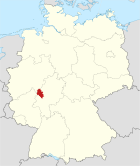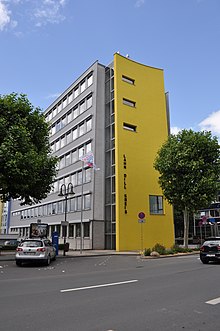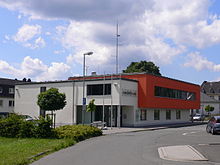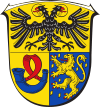Lahn-Dill district
| coat of arms | Germany map |
|---|---|

|

Coordinates: 50 ° 34 ' N , 8 ° 30' E |
| Basic data | |
| State : | Hesse |
| Administrative region : | to water |
| Administrative headquarters : | Wetzlar |
| Area : | 1,066.52 km 2 |
| Residents: | 253,319 (Dec. 31, 2019) |
| Population density : | 238 inhabitants per km 2 |
| License plate : | LDK, DIL, (WZ) |
| Circle key : | 06 5 32 |
| NUTS : | DE722 |
| Circle structure: | 23 municipalities |
| Address of the district administration: |
Karl-Kellner-Ring 51 35576 Wetzlar |
| Website : | |
| District Administrator : | Wolfgang Schuster ( SPD ) |
| Location of the Lahn-Dill district in Hesse | |
The Lahn-Dill-Kreis is a regional authority in the legal form of a district in the administrative district of Gießen in Hesse . The administrative seat is in the district town of Wetzlar and includes branches in Dillenburg , Herborn and Haiger .
The district is named after the two rivers Lahn and Dill . In the 1970s, the district was formed from the Lahn-Dill region or the Lahn-Dill area during a major regional reform , first in 1977 around the city of Lahn , after its dissolution a second time in 1979 in a smaller form, as a new district in Central Hesse , from parts of the old district of Wetzlar , the Dill district and peripheral communities of the former Biedenkopf district .
geography
location
The Lahn-Dill district is located in the west of Central Hesse on the border with North Rhine-Westphalia and Rhineland-Palatinate . The northern district includes the foothills of the Rothaargebirge , the western foothills of the Westerwald , the north-east the south-western Gladenbacher Bergland and the southern part of the central Lahn valley and parts of the eastern Hintertaunus . The highest point of the circle ( 673.1 m ) is located on the southern slope of the Rothaargebirge and in the community of Dietzhölztal located hunting Bergs ( 675.9 m ).
In particular, the Lahn and its right tributary Dill flow through the district - in valleys that shape the landscape. The Lahn, which comes from the direction of Gießen and Heuchelheim in the central Hessian district of Gießen , runs from the eastern Wetzlar district of Dutenhofen approximately in an east-west direction through the district and, among other things, through the core town of the district town of Wetzlar, where it absorbs the dill flowing in from the north ; it leaves the district near the Leun district of Biskirchen in the direction of the core town of Löhnberg in the neighboring district of Limburg-Weilburg .
Neighboring areas
The Lahn-Dill-Kreis borders in a clockwise direction in the north-east, starting with the Hessian districts of Marburg-Biedenkopf , Gießen , Wetteraukreis , Hochtaunuskreis and Limburg-Weilburg , the Westerwaldkreis in Rhineland-Palatinate and the Siegen-Wittgenstein district in North Rhine-Westphalia.
climate
A weather divide runs through the Lahn-Dill district, which, like all of Germany, belongs to the moderate climatic zone , which is mainly reflected in the significantly varying annual rainfall. More than 50% more precipitation falls in the north of the district than at some weather stations in the middle and south. ( Dietzhölztal Almonds: 1096.4 mm in contrast to only 718.9 mm in Ehringshausen -Kölschhausen, the lowest value in the district). In general, it is noticeable that the precipitation values from the north of the district with the foothills of the Rothaargebirge tend to fall southwards (Dietzhölztal almonds: 1096.4 mm; Eschenburg -Hirzenhain: 965.6 mm; Siegbach -Eisemroth: 841.4 mm; Wetzlar - Nauborn: 737.1 mm). There is an even greater difference between the places in the west and in the east of the southern Lahn-Dill district. In Driedorf, which belongs to the Westerwald, a total of 1229.1 mm of precipitation falls per year - more than 70 percent more than in Ehringshausen, which is only 15 km away as the crow flies.
The annual average temperatures in the Lahn-Dill district are close to the national mean of 8.2 ° C ( Aßlar- Klein Altenstädten: 8.4 ° C, in Dillenburg , which is slightly higher at 314 m , they are 7.7 ° C ).
history
The southern district belonged to the princes of Solms-Braunfels and the Free Imperial City of Wetzlar . This had to give up its imperial freedom in 1803 as a result of the Reichsdeputationshauptschluss , then as the County of Wetzlar , in favor of the newly created Grand Duchy of Frankfurt des Fürstprimas (in the old Reich Arch Chancellor ) Karl Theodor von Dalberg . The former Solms areas came to the Duchy of Nassau in 1806 and, in exchange, to Prussia in 1815 . In 1816 the Prussian districts of Wetzlar and Braunfels were created , which were combined to form the district of Wetzlar in 1822 . The district belonged to the Prussian Rhine Province as an exclave until 1932 . The northern district has belonged to the Principality of Nassau-Dillenburg since the Middle Ages , which belonged to the French-occupied Grand Duchy of Berg between 1806 and 1813 and to the Principality of Nassau-Orianen between 1813 and 1815, which became part of the Duchy of Nassau in 1816. This formed the two offices of Herborn and Dillenburg . After the Prussian annexation of the Duchy of Nassau in September 1866, both offices were combined to form the Dill District.
After the Second World War , the whole of today's district came to the state of Hesse. As part of the regional reform in Hesse , the Lahn-Dill district was formed on January 1, 1977 . The new circle was made up of
- the entire area of the dissolved Dillkreis with the cities of Dillenburg , Haiger and Herborn and the communities of Breitscheid , Dietzhölztal , Driedorf , Eschenburg , Greifenstein , Mittenaar , Siegbach and Sinn
- the largest part of the dissolved district of Gießen with the cities of Allendorf (Lumda) , Grünberg , Hungen , Laubach , Lich , Linden and Staufenberg and the communities of Buseck , Fernwald , Langgöns , Lollar , Pohlheim , Rabenau and Reiskirchen
- part of the dissolved district of Wetzlar with the cities of Braunfels and Leun and the communities of Aßlar , Biebertal , Bischoffen (formerly Biedenkopf district), Ehringshausen , Hohenahr , Hüttenberg , Schöffengrund , Solms and Waldsolms .
The new district had an area of 1695 km² and comprised a total of 36 communities. The seat of the district administration was the urban district “ Lahn ” , which was formed at the same time . This was created through the merger of the independent city of Gießen with the city of Wetzlar, 13 other communities from the district of Wetzlar and the community of Heuchelheim from the district of Gießen.
Because of violent protests, mainly from the Wetzlar population, the territorial reform was partially reversed. With effect from August 1, 1979, the city of Lahn was dissolved again and the Lahn-Dill district was redesigned:
- The restored city of Wetzlar and the newly formed municipality of Lahnau were incorporated into the Lahn-Dill district.
- The community of Biebertal and all communities that belonged to the district of Gießen until 1976 left the Lahn-Dill district and came to the newly established district of Gießen.
Since then, the Lahn-Dill district has comprised 23 cities and municipalities on an area of 1066.5 km².
Population development
The Lahn-Dill district received a new delimitation on August 1, 1979.
| date | Residents | source |
|---|---|---|
| June 30, 1977 | 312,000 | |
| June 30, 1979 | 314.200 | |
| June 30, 1980 | 240,000 | |
| December 31, 1990 | 247,400 | |
| December 31, 2000 | 262,859 | |
| September 30, 2010 | 253.923 | |
| June 30, 2015 | 251.704 | |
| June 30, 2019 | 253,670 |
politics
District council
The local elections on March 6, 2016 produced the following results, compared to previous local elections:
| Diagram showing the election results and the distribution of seats | |
|---|---|
| Nominations | % 2016 |
Seats 2016 |
% 2011 |
Seats 2011 |
% 2006 |
Seats 2006 |
% 2001 |
Seats 2001 |
||
|---|---|---|---|---|---|---|---|---|---|---|
| CDU | Christian Democratic Union of Germany | 31.2 | 25th | 34.7 | 28 | 38.1 | 31 | 35.4 | 29 | |
| SPD | Social Democratic Party of Germany | 29.9 | 24 | 32.9 | 27 | 35.2 | 28 | 39.5 | 32 | |
| AfD | Alternative for Germany | 10.0 | 8th | - | - | - | - | - | - | |
| FWG | Free voter community Lahn-Dill | 10.0 | 8th | 10.6 | 9 | 11.4 | 9 | 10.6 | 9 | |
| GREEN | Alliance 90 / The Greens | 8.3 | 7th | 13.6 | 11 | 5.6 | 5 | 5.8 | 5 | |
| FDP | Free Democratic Party | 5.4 | 4th | 3.1 | 2 | 4.2 | 3 | 4.1 | 3 | |
| THE LEFT. | THE LEFT. | 3.2 | 3 | 2.7 | 2 | 2.2 | 2 | - | - | |
| NPD | National Democratic Party of Germany | 2.0 | 2 | 2.4 | 2 | 2.0 | 2 | 1.8 | 1 | |
| REP | The Republicans | - | - | - | - | 1.3 | 1 | 2.7 | 2 | |
| total | 100.0 | 81 | 100.0 | 81 | 100.0 | 81 | 100.0 | 81 | ||
| Voter turnout in% | 44.5 | 41.3 | 40.4 | 47.7 | ||||||
District administrators
- Ernst Türk (SPD), January 1, 1977 to June 15, 1977 (State Commissioner District Administrator after the regional reform)
- Karl Rehrmann (CDU), June 16, 1977 to July 31, 1979 and August 1, 1979 to July 31, 1981 (State Commissioner District Administrator after the regional restructuring on August 1, 1979)
- Franz Demmer (CDU), August 1, 1981 to June 10, 1985
- Gerhard Bökel (SPD), June 11, 1985 to July 11, 1994
- Karl Ihmels (SPD), November 7, 1994 to November 6, 2006
- Wolfgang Schuster (SPD), since November 7, 2006
Coat of arms, flag and banner
| Blazon : “Divided: above in gold a red armed black double-headed eagle; Split at the bottom: in front in gold a blue hunting horn with a red ribbon, behind in a blue field sprinkled with gold shingles a red armored golden lion. " | |
| Reasons for the coat of arms: The imperial eagle symbolizes the former free imperial city of Wetzlar, the hunting horn the county of Orange and the lion the principality of Nassau . The coat of arms was awarded on August 4, 1980. |
Economy and Transport
economy
In the future atlas 2016 , the Lahn-Dill district was ranked 222 out of 402 districts, municipal associations and urban districts in Germany, making it one of the regions with a “balanced risk-opportunity mix”. In the 2019 edition, it was ranked 211 out of 401.
traffic
The federal motorways 45 ( Aschaffenburg - Dortmund ) or E 40 , E 41 and 480 (Wetzlar - Reiskirchen E 40; section from the Wetzlarer Kreuz to the current exit to Wetzlar- Blasbach ) run through the district . In addition, several federal and district roads open up the district area, including the B 49 and E 44 , B 253 , B 255 , B 277 and the former B 277a .
The Verkehrsverbund Lahn-Dill (VLD) and the local public transport company Kreis Limburg-Weilburg mbH (LNG) merged at the beginning of September 2011 to form the Verkehrsgesellschaft Lahn-Dill-Weil mbH (VLDW). As the public transport authority, it is responsible for local public transport in the Lahn-Dill district and in the Limburg-Weilburg district, with the exception of the area of the city of Wetzlar, which organizes public transport independently through its local public transport organization. On school days, a total of 250 vehicles run daily on regional and local lines. The VLD operates 554 stops in the Lahn-Dill district. Seven transport companies are currently operating on behalf of the VLDW. The number of kilometers driven in the timetable is around 5.7 million per year. In Wetzlar, the Wetzlarer Verkehrsbetriebe GmbH (Gimmler), on behalf of the local transport organization of the city of Wetzlar, travel to 220 stops on 10 local lines with an annual traffic performance of approx. 1.4 million commercial vehicle kilometers. In December 2017, an on-call bus system and the first cross-border bus line to Rennerod in Rhineland-Palatinate were introduced. Since December 2009, Wetzlar, Herborn and Dillenburg have been served daily by a pair of trains on the international Eurocity long-distance train , which traveled from Siegen via Frankfurt, Stuttgart and Munich to Klagenfurt am Wörthersee as well as Ljubljana and Zagreb . This connection was discontinued at the 2011 timetable change.
The Dill route of Deutsche Bahn AG runs through the district area with regional express connections from Frankfurt am Main or Gießen via Wetzlar and Dillenburg to Siegen (there connection in the direction of Hagen and Cologne ) as well as with the Mittelhessen Express , which serves the municipalities of the middle Lahn-Dill-Kreis connects with Frankfurt without changing trains. Long-distance traffic on the route was discontinued. In addition, the trains run on the Lahn Valley Railway from Gießen via Wetzlar - Weilburg - Limburg to Koblenz . On the edge, the Hellertalbahn from Dillenburg via Burbach to Betzdorf touches the district area. In the south there is a connection from Brandoberndorf to Bad Homburg and Frankfurt via the Taunusbahn . The VLD bought the part of the line in the district in 1996 from Deutsche Bahn AG. Larger train stations are in Wetzlar , Herborn and Dillenburg .
Communities
(Residents on December 31, 2019)
|
|
Municipalities in the district |
Attractions
- Aartalsee near Bischoffen
- Braunfels Castle
- Werdorf Castle , which houses the local history museum of the city of Asslar
- Stalactite cave "Autumn Labyrinth" near Breitscheid
- Wildlife Park in Donsbach
- Wilhelmsturm in Dillenburg
- Krombach dam near Driedorf
- Greifenstein Castle in the Westerwald
- historic old town of Herborn with a multitude of monuments and half-timbered houses
- Bird and nature protection park in Herborn-Uckersdorf
- Villa Haas , built around 1892, a listed building of historicism in mind
- Fortuna visitor mine near Solms-Oberbiel / Wetzlar
- old imperial city of Wetzlar , cathedral and old town
- Museums in Wetzlar
- Coptic monastery in Kröffelbach
- Ulmbach reservoir near Beilstein
License Plate
On 1 January 1977. the Lahn-Dill was just like the short-lived independent city Lahn the distinguishing sign L assigned. It was issued until October 31, 1990. After reunification , the L had to be ceded to the independent city and the district of Leipzig. The Lahn-Dill district received the new distinctive sign LDK on November 1st, 1990 . The license plates with the letter L previously approved in the Lahn-Dill district , however, remain valid indefinitely. The Leipzig and “Lahner” license plates could be differentiated from 1991 to 2011 based on the number of digits. Leipzig license plates initially only had four digits. The old license plates of the Lahn-Dill district had license plates up to three digits. The four-digit number plate combinations for the city of Lahn were initially not issued in Leipzig. Only since 2008 can vehicles registered in the city and district of Leipzig receive all identification numbers originally reserved for the Lahn-Dill district and the independent city of Lahn. The Saxons have only been making increasing use of this since around 2011. In fact, apart from the stamp, the few remaining Lahn-Dill-L markings can only be recognized by the non- Euro design .
For the special status town of Wetzlar, the distinctive sign WZ was reintroduced on July 1, 2012 and since May 2, 2014, the distinction sign DIL (Dill district) has also been available due to the license plate liberalization in the Lahn-Dill district, with the exception of the city of Wetzlar .
Web links
|
Further content in the sister projects of Wikipedia:
|
||
|
|
Commons | - multimedia content |
- Website of the Lahn-Dill-Kreis
- Lahn-Dill district. Historical local dictionary. In: Landesgeschichtliches Informationssystem Hessen (LAGIS).
- Link catalog on the subject of the Lahn-Dill district at curlie.org (formerly DMOZ )
Individual evidence
- ↑ Hessian State Statistical Office: Population status on December 31, 2019 (districts and urban districts as well as municipalities, population figures based on the 2011 census) ( help ).
- ^ Michael Rademacher: German administrative history from the unification of the empire in 1871 to the reunification in 1990. wetzlar.html. (Online material for the dissertation, Osnabrück 2006).
- ^ Hesse climate data. Retrieved July 16, 2012 .
- ↑ Law on the restructuring of the Dill district, the districts of Gießen and Wetzlar and the city of Gießen (GVBl. II 330–28) of May 13, 1974 . In: The Hessian Minister of the Interior (ed.): Law and Ordinance Gazette for the State of Hesse . 1974 No. 17 , p. 237 , second section; § 29 ( online at the information system of the Hessian state parliament [PDF; 1,2 MB ]).
- ^ Federal Statistical Office (ed.): Historical municipality directory for the Federal Republic of Germany. Name, border and key number changes in municipalities, counties and administrative districts from May 27, 1970 to December 31, 1982 . W. Kohlhammer, Stuttgart / Mainz 1983, ISBN 3-17-003263-1 , p. 381 .
- ↑ a b Statistical Yearbook for the Federal Republic of Germany 1980
- ↑ Statistical Yearbook for the Federal Republic of Germany 1978
- ^ A b Michael Rademacher: German administrative history from the unification of the empire in 1871 to the reunification in 1990. Lahn-Dill-Kreis. (Online material for the dissertation, Osnabrück 2006).
- ↑ Hessian State Statistical Office
- ↑ Population in the administrative districts on September 30, 2010 and population processes in the 3rd quarter of 2010. Hessian State Statistical Office, archived from the original on May 10, 2011 ; accessed on May 31, 2019 .
- ↑ Population in the administrative districts on June 30, 2015 and change in population in the 2nd quarter of 2015. Hessian State Statistical Office, archived from the original on March 24, 2016 ; accessed on May 31, 2019 .
- ↑ Population in the administrative districts on June 30 , 2019 and change in population in the 2nd quarter of 2019. Hessian State Statistical Office, accessed on October 7, 2019 .
- ^ Hessian State Statistical Office: Results of the district elections of 2016 and 2011
- ^ Hessian State Statistical Office: Results of the district elections of 2011 and 2006
- ^ Hessian State Statistical Office: Results of the district elections of 2006 and 2001
- ^ Hessian State Statistical Office: Results of the district elections of 2001 and 1997
- ↑ 2006 election: WASG
- ↑ Zukunftsatlas 2016. Archived from the original ; accessed on March 23, 2018 .
- ↑ Future Atlas 2019. Accessed December 10, 2019 .
- ↑ Presentation of the Lahn-Dill transport association on its website
- ↑ New mobility with the VLDW's RufBus , accessed on December 20, 2018
- ^ SPNV Nord, 60th Association Assembly, Item 6: Deutschlandtakt: Evaluation of the current planning status from the perspective of SPNV-Nord , December 5, 2018, p. 60, accessed on December 20, 2018
- ↑ Hessian State Statistical Office: Population status on December 31, 2019 (districts and urban districts as well as municipalities, population figures based on the 2011 census) ( help ).






